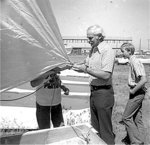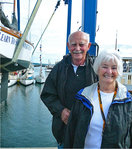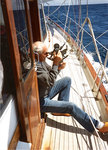Jim “Daubie” Daubenberger’s passion for sailing took him to the water for the first time in 1937, when, at the age of 13, he hatched a plan to sail Discovery Bay in a rented rowboat using his …
This item is available in full to subscribers.
We have recently launched a new and improved website. To continue reading, you will need to either log into your subscriber account, or purchase a new subscription.
If you had an active account on our previous website, then you have an account here. Simply reset your password to regain access to your account.
If you did not have an account on our previous website, but are a current print subscriber, click here to set up your website account.
Otherwise, click here to view your options for subscribing.
* Having trouble? Call our circulation department at 360-385-2900, or email our support.
Please log in to continue |
|



Jim “Daubie” Daubenberger’s passion for sailing took him to the water for the first time in 1937, when, at the age of 13, he hatched a plan to sail Discovery Bay in a rented rowboat using his dad’s pup tent for a sail.
There was no Internet and barely any information available about sailing. His sail plan came from a picture he found in the dictionary. Jim gathered the parts for his sailing rig in the family’s backyard and garage. He borrowed some line and his dad’s pup tent, but was not allowed to cut or alter either in any way. He found a couple of poles for a mast and boom.
Then, on a weekend trip to a family picnic spot on Adelma Beach on Discovery Bay, he put his boat together. He lashed the two poles together to make the mast and boom, folded the heavy cotton tent into a triangle and tied it to the makeshift rig, rented a rowboat for a dime and start rowing toward Beckett Point.
Jim rowed upwind until he couldn’t wait any longer, turned the boat downwind, shipped the oars, fixed his sailing rig at the forward thwart, held one of the oars at the transom for a rudder and, reminiscent of a Jack London story, was off on his first sailing adventure. He sailed that day, rowing upwind then sailing downwind, until he was forced to return the boat to the rental stable. That was the beginning of his lifelong love of sailing.
Another sailing opportunity arose in Port Townsend a year or two later. The local Sea Scout Troop acquired a 40-foot Navy launch rigged for sailing as a ketch. Jim was not old enough to join the Sea Scouts, so was not allowed to sail with his friends Bobby Jones and Bob Porter. Undeterred, he spent hours hanging around on the dock with his friends while the boat was being fixed up. Soaking up the paint- and pine-tar-filled atmosphere fueled his fire to learn how to sail.
NAVY EXPERIENCE
Jim graduated from Port Townsend High School in 1942. Like most young men his age, he joined the military – the U.S. Navy – and before long, he was a machinist’s mate aboard the submarine chaser SC 1042. Doing escort missions for merchant ships out of New Caledonia in the South Pacific, Jim found another sailboat. The Navy had a ketch-rigged whale boat for use by officers and enlisted men who possessed sailing skills. Jim promoted himself as an experienced sailor and volunteered to skipper the boat for an afternoon sail. With a few of his shipmates and almost no idea what he was doing, he headed out under sail for the second time in his life. They returned to the dock with boat and crew intact and Jim certain that he would one day have a sailboat of his own.
After the war, Jim returned to Port Townsend and, with wife Donna, started their family and business. Before long, he was out sailing with old friends Bobby Jones and Bob Porter aboard their newly acquired Tahiti ketch, Takuan, one of three sailboats based in Port Townsend at the time. The other two were Steam Boat Smith’s 23-foot cutter Sail Ho and a second Tahiti ketch, whose name and owner have been lost to memory.
These trips involved reaching back and forth across Port Townsend Bay and out into the Strait of Juan de Fuca. The Takuan was slow and unresponsive, but there was wind in the sails and water under her keel, plus a toasty warm woodstove down below for the cold fall and winter days.
REGATTA IN 1957
Jim’s big break in sailing came in 1957. The Pacific International Yacht Association Regatta (PIYA) was being hosted in Port Townsend. It was reported that 180 boats came to town for the event, comprising a multitude of classes, including Snipes, Geary 18s, International 14s, Thistles, International 110s, Stars, 6-meters and numerous offshore-class boats, such as Spitzgatters, Seafarers and K 38s. Jim put his name on the chalkboard early Friday as available crew with sailing experience but no racing, and then showed up bright and early on Saturday morning at Point Hudson Marina ready to find a job on any boat that would take him. Boats started pouring out of the marina for the race courses, and he felt his opportunity for a ride ebbing out with them. By now, sitting on the side of the dock with only a few possible boats left, Jim was approached by Canadian Hunter Vogle who, with his wife and two sons, raced their Spitzgatter sloop competitively around Canada and Puget Sound. Hunter introduced himself and said to Jim, "You really want to go sailing, don't you?" To which Jim replied, "You bet I do!”
In those days, the PIYA regatta was a weeklong premier event that attracted boats from all over the region. There were courses for the dinghy classes, small keel boats and open-cockpit boats in Port Townsend Bay, and longer courses outside the bay for the bigger, more seaworthy classes. As Jim remembers, the first race for the bigger boats was out to Middlepoint buoy and back to Port Townsend. Day two sent them down to Port Hadlock and back, and the next couple of days were a port-to-port style race that took them to Discovery Bay for an overnighter.
The parties were even longer, with many revelers working hard into the early-morning hours but ready to hit the race course for another day of afternoon westerlies.
THE KOTKINS BOAT
Jim was blessed to have met and sailed with Hunter and his family for the regatta's first half, but the person he met next would change his sailing experience forever. Hanging out on the dock after the third day of racing, Jim was approached by a man who needed crew for the rest of the regatta. He had already happily committed to another day crewing for the Vogels, but said he would be available afterward if the skipper, Henry Kotkins, could use him. Soon Jim stepped aboard Henry’s brand-new K 38 Totum. Jim didn't know it that day, but his relationship with Henry would span decades and many races.
Henry was a good sailor and a great organizer. He always had talented crew aboard his boats, but more than that, they were a group of guys who loved to have fun. Jim sailed with Henry on the K 38 and later the 72-foot yawl Diamondhead in all of the Tri-Island Series races, Swiftsure and the PIYA regattas, wherever they were being held, for the next 20 years. It was always exciting to see the impressive 72-footer pull into Point Hudson to pick up Jim on its way from Seattle to Victoria for the annual Swiftsure race. Once Jim was onboard and the boat was out of the marina, Henry would always ask, "What's our course and tide, Jimmy"?
In 1960, Jim and Donna, now with four kids, bought their first boat, an 18-foot Seagull class centerboard sloop named Gwyllyn. Jim found the boat in Port Angeles and borrowed a trailer to get it to Port Townsend.
At this same time, Jim and Donna's lifelong friends Glen and Marge Abraham, with their two daughters, purchased an Arrowhead sloop. Asked the name of the boat, Marge Abraham stated that "the boat was so uncomfortable we didn't name it, because we hoped we wouldn't own it long.” In no time, the two families were out on the water rain or shine, for day sails and overnight cruises with boom tents.
Within the next couple of years, Jim was ready for the next upgrade. A boat with more performance and accommodation, the choice was a 21-foot Victory class sloop. Along with the new boat came another Port Townsend family into sailing – Bill and Z Scheyer with their daughter and son. They ordered a Victory and got started day sailing with the others. The typical summer Sunday took the families down to Kuhn Spit with full coolers and dinghies in tow. The kids could swim in the slough as the tide came in, while the adults lounged in their cockpits with sandwiches and a beer. The sail home came with the predictable afternoon westerly, with wet kids hunkered down in the cuddy cabin and the spray flying. During the Victory days, the Abrahams would frequently bring the 26-foot powerboat that was built in Glen Cove by Mr. Winter and belonged to Marge's parents. It was a popular addition to the fleet because it was fitted with a marine head instead of a bucket.
ON TO SAN JUANS
With Port Townsend Bay and the local anchorages scoured to the south, Jim's next step was to cross the Strait of Juan de Fuca to the holy grail of local cruising: the San Juan Islands. He was already familiar with the straits, having made the trip many times on race boats, but this would be the first solo trip in a 21-foot open boat. The plan was to go early in the morning, so the babysitters came the night before and settled in to watch the kids for the next four days. The weather was good, the tide was right, and neither Jim nor Donna could sleep, so with the boat ready and waiting in its slip, they decided to make their crossing that night.
With the first big trip a huge success, Jim's next boat was in his crosshairs.
This time it would be three new 26-foot Thunderbird class sloops: No. 241 (Zaca) for the Scheyer family, No. 242 (Dorado) for the Daubenbergers, and No. 243 (Caveat) for the Abrahams. (Today these three sisters are back together again in Port Townsend.) The boats were built at Knottingham Marine in Seattle and, one by one, were delivered to Port Townsend by Bill, Glen and Jim using the same outboard motor for each delivery. These were real boats with a cabin and bunks, self-bailing cockpits and each boat was equipped with a marine head.
The cost of each boat, including sails and other options, was $2,650. When Jim brought Dorado into Point Hudson Marina for the first time, he said, "The boat is so big, I can hardly see the bow.”
Jim spent every spare minute either working on his boat or sailing it. There were Wednesday-night races, evening sails, weekend adventures with the three families and anyone else who wanted to join in the fun, plus the two summer cruises to the San Juans and Canadian Gulf Islands. Jim and Glen spent untold hours planning the summer cruises, talking over coffee at the Delmonico, or poring over the charts with a drink in the evening.
SIX SAILBOATS
It was 1963 and there were now six sailboats in Port Townsend: Bobby’s and Bob's Tahiti ketch, Steam Boat Smith’s little cutter, plus Don Holm’s plank-on-frame sloop Freya and now the three Thunderbirds.
At about the same time, Earl Helander approached Glen and Jim with two suggestions: That they join the Port Townsend Yacht Club (PTYC), and that they put together a youth sailing program. They did both. Earl, through the club, bought two 10-foot Sea Scouter sailing dinghies. By the next summer, the Port Townsend Kiwanis Club had raised the funds for two more boats. Together, Jim, Glen and later Jody Stuart and Ann Welch, a former sailing student, ran the summer sailing program out of the small PTYC building for more than 20 years.
They taught hundreds of kids how to sail. The kids had to be 12 (unless you were a Daubenberger or an Abraham; then, 11 would get you in a boat), and you had to have a life jacket. If you didn't, you could borrow an ill-fitting one from the club and if you were lucky, it would be made of cotton and kapok instead of canvas and cork. Golden memories, friendships and adventure were spawned out of the long summers on the water.
The beginning sailing classes started kids out with basic boat handling skills, some nomenclature, knot-tying and race rules. Then kids were sent out on their own. For the advanced classes, most kids brought their own boats and fixed them up to race with sail slides, mast track and boom vangs, and then competed in the August series and the National Sea Scouter Championship, usually held in Port Townsend.
Racing was the body of the program that Jim and Glen taught. The kids learned how to sail to windward and leeward right off the bat. The logic of racing is that if you can sail windward and leeward, you can go anywhere. Like their instructors, all of the kids with their own boats started taking extended trips around the bay, and it wasn't unusual to see two or three of the little Sea Scouters beached at Chetzemoka Park or Fort Worden, or the more adventurous crews heading over to Rat Island or Kuhn Spit for the day or an overnight cruise.
Many former students from this summer sailing program have gone on to maritime careers, made extended ocean voyages, taught their own children how to sail, and introduced thousands of people to the joy of sailing. Glen, Jim, Jody and Ann created “the ultimate pay it forward,”" and it is still going on today.
RACING RELIGIOUSLY
Now with a successful sailing program going all summer and with growing families, Jim and Glen were looking for the ultimate cruising and racing boats, and found them. Jim's was the 35-foot Cheoy Lee Lion class sloop, Stella Maris. She was fiberglass, but had teak decks, cabin sides and hatches; the spars were spruce, and Jim kept the boat polished and varnished for the many years he owned her, eventually painting the hull black.
Glen's boat was a plank-on-frame, Garden-designed yawl named Taku. She was long and lean, with a stepped cabin, and could sport a mizzen staysail. Jim, with Donna, and Glen, with Marge, raced and cruised with their families and into retirement with these boats. They entertained hundreds of people over the years in the bay and on their cruises. They were ambassadors to the sailing and cruising community wherever they went.
Jim raced religiously in any conditions and invited anyone who wanted to learn how to sail to come along. The black Cheoy Lee became a Wednesday-night icon, and though Jim had many loyal crews over the years, he often sailed shorthanded. But he always carried his spinnaker and always placed well. Jim and Glen would go in almost any weather, and in all those years, never had more to navigate with than a clock, a compass, a chart, a pair of parallel rules and dividers.
Jim and Donna sailed with both of their sons in the Caribbean (aboard Kilibogus), in the Sea of Cortez (aboard Joshua); and Jim made an Atlantic passage (aboard Atoll), and, with both boys, a delivery that included the Gulf of Alaska in late September.
There were other boats for Jim and Donna, including a Pearson 35, Sadie J, and his little Ranger 23, Sadie J II.
Ask anyone who knows Jim Daubenberger and they will smile and more often than not have a story that is funny or generous or wise in a low-key way.